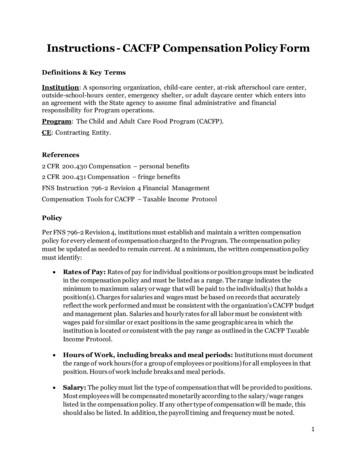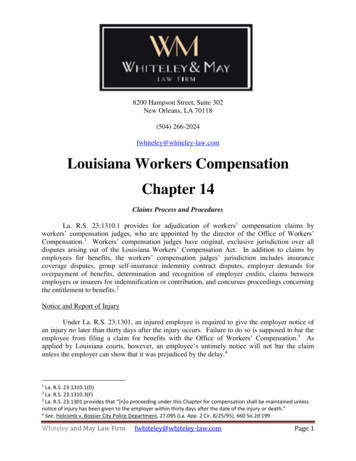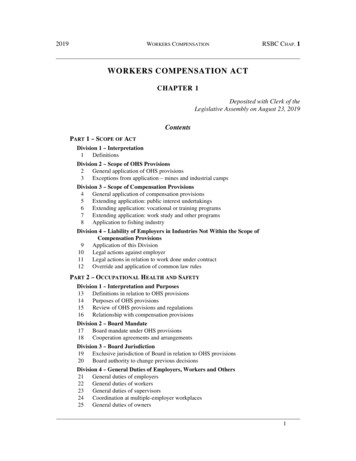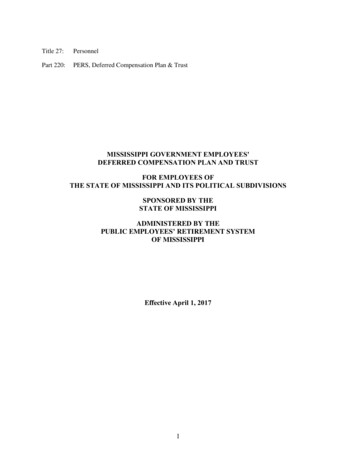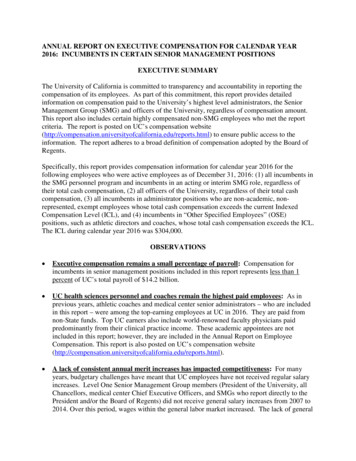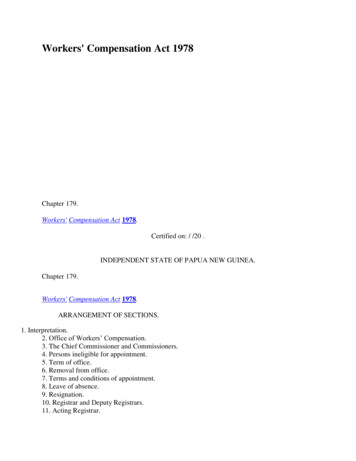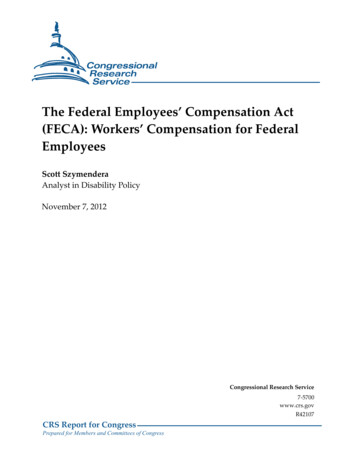
Transcription
The Federal Employees’ Compensation Act(FECA): Workers’ Compensation for FederalEmployeesScott SzymenderaAnalyst in Disability PolicyNovember 7, 2012Congressional Research Service7-5700www.crs.govR42107CRS Report for CongressPrepared for Members and Committees of Congress
The Federal Employees’ Compensation Act (FECA)SummaryThe Federal Employees’ Compensation Act (FECA) is the workers’ compensation program forfederal employees. Like all workers’ compensation programs, FECA pays disability, survivors,and medical benefits, without fault, to employees who are injured or become ill in the course oftheir federal employment and the survivors of employees killed on the job. The FECA program isadministered by the Department of Labor (DOL) and the costs of benefits are paid by eachemployee’s host agency. Employees of the U.S. Postal Service (USPS) currently comprise thelargest group of FECA beneficiaries and are responsible for the largest share of FECA benefits.The modern FECA program can trace its roots to 1916 but has not been significantly amendedsince 1974. Today, the FECA program pays a basic disability benefit equal to two-thirds of aninjured worker’s pre-disability wage, which rises to 75% of the pre-disability wage if the workerhas any dependents. Benefits continue for the duration of disability or the life of the beneficiaryand in cases of traumatic injuries, beneficiaries can receive a continuation of their full pay for thefirst 45 days. Persons with specific permanent partial disabilities, such as the loss of a limb, areentitled to disability benefits for a set number weeks provided by schedules set by statute andregulation. All medical costs associated with covered conditions are provided by the FECAprogram without any copayments, cost-sharing, or use of private insurance by the beneficiaries.The survivors of employees killed on the job are entitled to cash benefits based on the worker’swages and a modest benefit for funeral costs. Beneficiaries are also entitled to vocationalrehabilitation services to assist them in returning to work.In the 112th Congress, several committees have held hearings on the FECA program. Thesehearings have identified several key policy issues facing the program, including thedisproportionate share of claims and program costs attributed to postal workers, the payment ofFECA benefits after retirement age, the overall generosity of FECA disability benefits ascompared with those offered by the states, and the administration of the FECA program.To address some of these policy issues, committees in the House and Senate passed legislationthat would make changes to the FECA program. In the House, H.R. 2309 would set financialconditions under which the USPS would be required to create a new workers’ compensationsystem for its employees. Additional bills, H.R. 2465, passed by the House, and S. 1789, wouldmake changes to the FECA program for all federal employees with the Senate legislationreducing benefit levels for beneficiaries over retirement age and eliminating augmentedcompensation for dependents.This report will be updated to reflect major legislative activity.Congressional Research Service
The Federal Employees’ Compensation Act (FECA)ContentsIntroduction. 1Legislative History of FECA . 1Limited Workers’ Compensation for the United States Life Saving Service and OtherHazardous Federal Occupations . 1The Federal Employees’ Compensation Act of 1916 . 2Congressional Intent. 2Major FECA Amendments . 31949 Amendments . 31960 Amendments . 61966 Amendments . 61974 Amendments . 7Recent FECA Amendments . 8Change to the FECA Waiting Period for Postal Employees . 8Death Gratuity for Federal Employees Killed While Serving Alongside theArmed Forces . 8Overview of the FECA Program Today . 9Statutory and Regulatory Authorities . 9Program Financing . 9FECA Benefit and Administrative Costs . 9Employees Covered by FECA . 10Conditions Covered by FECA . 10FECA Claims Process. 11Time Limit for Filing FECA Claims . 11FECA Compensation Benefits . 11Continuation of Pay. 11Partial Disability. 11Total Disability . 12Death . 13FECA Medical Benefits . 13Vocational Rehabilitation . 14Coordination with Other Benefits. 14Coordination with Retirement Benefits for Federal Employees . 14Coordination with Disability Retirement Benefits . 15Coordination with Social Security Disability Insurance Benefits . 15Coordination with Social Security Retirement Benefits . 16Selected Current Issues Facing the FECA Program . 16FECA and the U.S. Postal Service. 16Legislative Activity . 18FECA and Retirement Age . 18Policy Considerations. 19Legislative Activity . 20FECA Benefit Generosity . 20Legislative Activity . 21Program Administration . 22Insurance . 22Settlements . 22Congressional Research Service
The Federal Employees’ Compensation Act (FECA)Legislative Activity . 23TablesTable 1. FECA Benefits and Costs, FY2009. 10Table 2. FECA Cases, FY2010 . 17Table 3. Lost Time FECA Cases and Lost Production Days due to Injuries, Illnesses, andDeaths, FY2010 . 18Table A-1. FECA Scheduled Benefits for Partial Disability Compensation . 24AppendixesAppendix. FECA Scheduled Benefits . 24ContactsAuthor Contact Information. 25Congressional Research Service
The Federal Employees’ Compensation Act (FECA)IntroductionThe Federal Employees’ Compensation Act (FECA) is the workers’ compensation system forfederal employees. Every civilian employee of the federal government, including employees ofthe legislative and judicial branches, is covered by FECA, as are several other groups, includingfederal jurors and Peace Corps volunteers. In FY2009, the FECA program paid out more than 2.7 billion in benefits, including 1.8 billion in disability benefits, 847 million in medicalbenefits, and 138 million in benefits to the survivors of federal employees killed on the job.1 InFY2009, administrative expenses made up 4.9% of total program costs.2Legislative History of FECAThe FECA program has its origins in a law from the late 1800s that covered only the employeesof a federal agency that has long since ceased to exist on its own. The modern FECA system hasits roots in legislation enacted in 1916; many of the basic provisions of this original law, such asthe basic rate of compensation, are still in effect today. Congress passed major amendments to the1916 legislation in 1949, 1960, 1966, and most recently in 1974. Although these amendmentsmade significant changes to the FECA program, the basic framework of the program endures asdoes the overall intent of Congress through the years to maintain a workers’ compensation systemfor federal employees that is in line with the basic principles that have governed workers’compensation in this country for a century.Limited Workers’ Compensation for the United States Life SavingService and Other Hazardous Federal OccupationsThe first workers’ compensation law for federal employees was enacted in 1882 and provided upto two years of salary to any member of the federal United States Life Saving Service disabled inthe line of duty and two years of salary to his or her survivors in case of a line of duty death.3 In1908, Congress passed a more comprehensive workers’ compensation law for federal employeesengaged in certain hazardous occupations, such as laborers at federal manufacturing facilities andarsenals or workers at the construction of the Panama Canal. This law provided workers with upto one year of salary, after a 15-day waiting period, if disabled due to an employment-relatedinjury and their survivors with up to a year of salary in case of death.The 1882 and 1908 federal workers’ compensation laws did not provide universal coverage for allfederal employees. It is estimated that only one-fourth of the federal workforce was covered bythe 1908 law, and the law was clearly designed only to provide coverage for what were seen to bethe most hazardous jobs in the civil service.4 President Theodore Roosevelt recognized this1Department of Labor, Office of Workers’ Compensation Programs, Annual Report to Congress: FY2009,Washington, DC, April 27, 2011, p. 7.2Ibid, p. 15.3Act of May 4, 1882, ch. 117, 22 Stat. 55 (1882). In 1915 the United States Life Saving Service was merged with theRevenue Cutter Service to form the United States Coast Guard.4Willis J. Nordlund, “The Federal Employees’ Compensation Act,” Monthly Labor Review, September 1991, p. 5.(Hereafter cited as Nordlund 1991.)Congressional Research Service1
The Federal Employees’ Compensation Act (FECA)shortcoming of the law he would eventually sign. Before the 1908 law’s passage, he called onCongress to pass a workers’ compensation bill that would cover “all employees injured in thegovernment service” and stated that the lack of such a comprehensive workers’ compensation lawwas “a matter of humiliation to the nation.”5In addition to only covering a small portion of the federal workforce, the 1882 and 1908 laws didnot provide for medical benefits for disabled workers, and the 1908 law only applied in cases ofdisability or death arising from injuries and not illnesses.The Federal Employees’ Compensation Act of 1916President Woodrow Wilson signed the Federal Employees’ Compensation Act, P.L. 64-267, intolaw on September 7, 1916, and in so doing extended the protections of the modern workers’compensation system to nearly all federal employees. This original FECA law remains the basisfor the workers’ compensation system for the federal civil service.The FECA law provided coverage for nearly all civilian employees of the federal governmentinjured or killed in line of duty. Coverage was not provided for occupational illnesses.6 The lawprovided full medical coverage for covered injuries provided by government physicians andhospitals or private medical services selected by the government. Disability compensation wasprovided, after a three-day waiting period, at a rate of two-thirds of the worker’s wage for totaldisability, with adjustments for partial disabilities. Disability benefits were subject to minimumand maximum levels specified in the law and neither benefits nor these levels were subject to anycost-of-living or other annual adjustments. The survivors of an employee killed on the job wereentitled to cash benefits based on the worker’s wage and were also entitled to a benefit to helpoffset funeral costs.The 1916 legislation created the Federal Employees’ Compensation Commission, with threemembers appointed by the President with the advice and consent of the Senate, to administer theFECA program. Benefit and administrative costs associated with the program were paid out of theEmployees’ Compensation Fund created by the law and financed with permanently authorizedappropriations.Congressional IntentBringing the Federal System in Line with the StatesCongress had several clear intentions when drafting the FECA program in 1916. One suchintention was to bring the protections offered to federal employees in line with those beingoffered by a majority of the states at the time, with the House Judiciary Committee reporting thatsuch state laws were “working with most excellent results.”7 In addition, the committee reported5U.S. Congress, House Committee on Education and Labor, Subcommittee on Safety and Compensation, Amendmentsto Federal Employees’ Compensation Act, hearings on H.R. 1196 and other bills to amend the Federal Employees’Compensation Act, 86th Cong., 2nd sess., February 10, 23, 24 and March 8, 23, 24, 1960 (Washington: GPO, 1960), p.124.6Coverage for occupational illnesses was added to the FECA program in 1924 by P.L. 68-195.7U.S. Congress, House Committee on the Judiciary, Compensation of Government Employees Suffering Injuries While(continued.)Congressional Research Service2
The Federal Employees’ Compensation Act (FECA)that the schedule of compensation for disability in FECA was “in line with the best precedentsfound in State compensation acts,” especially those in Massachusetts, New York, and Ohio.8Providing Coverage to all Federal EmployeesAn additional intention of Congress was to provide workers’ compensation coverage to all federalemployees regardless of occupation, thus correcting what was seen as a shortcoming of the 1908act. The House Judiciary Committee’s report on the 1916 FECA legislation criticizes the limitedcoverage of the 1908 law and states,The present law, in denying compensation to an injured employee if his occupation was not“hazardous” goes counter to the theory on which all compensation acts are based, viz, thatthe industry shall bear the burden of injuries caused by it.9This criticism of the limited coverage provided by the 1908 act, and the intention of the FECAlegislation to correct this shortcoming, was echoed by the FECA legislation’s sponsor in theSenate, Senator George Sutherland. Senator Sutherland, in a Senate Judiciary Committee hearingon the legislation, stated,The theory upon which compensation laws are drawn is that you are to compensate for theinjury, not for the risk that the man ran in bringing about the injury; and under modernthought there is no logical reason for making distinction between what is hazardous and nonhazardous employment.10Senator Sutherland reinforced his point with a rather graphic example stating “the clerk who hashis leg cut off in his work about a store is just as effectively deprived of his leg as if it was cut offby a machine.”11Major FECA AmendmentsCongress has passed major amendments to the FECA program in 1949, 1960, 1966, and mostrecently in 1974.1949 AmendmentsThe Federal Employees’ Compensation Act Amendments of 1949, P.L. 81-357, brought about thefirst set of significant changes to the FECA program since its inception in 1916. The 1949amendments, in the words of the House Committee on Education and Labor, sought to(.continued)on Duty, report to accompany H.R. 15316, 64th Cong., 2nd sess., May 11, 1916, H. Rept. 64-678 (Washington: GPO,1916), p. 7.8Ibid., p. 9.9Ibid., p. 8.10U.S. Congress, Senate Committee on the Judiciary, Accident Compensation to Government Employees, hearing on S.2846, 64th Cong., 1st sess., February 26, 1916 (Washington: GPO, 1916), p. 27.11Ibid.Congressional Research Service3
The Federal Employees’ Compensation Act (FECA)“modernize and liberalize” the FECA program, which, according to the Senate Committee onLabor and Public Welfare, provided “only illusory security for most workers or their families.”12Increased FECA CoverageThe 1949 amendments expanded the scope of workers covered by the FECA program to includethose classified as “officers” of the United States. The amendments also doubled the maximumdisability benefit level, thus providing for a replacement of a larger portion of federal employeepay.In addition to better meeting the goal of universal coverage of all employees, the inclusion offederal government officers was intended to provide FECA protections to previously excludedemployees, such as Foreign Service Officers, who may serve in dangerous overseas areas. Theincrease in the maximum benefit level was necessary since, at the time, it was estimated by theDepartment of Labor (DOL) that 90% of FECA cases involved workers with wages that wereessentially not covered by the program because of the low maximum benefit level.13Increased FECA BenefitsSeveral provisions of the 1949 amendments effectively increased FECA benefits for workers andtheir survivors. The three-day waiting period for FECA disability compensation was eliminated incases of disability lasting more than 21 days. A schedule of benefits for permanent partialdisabilities was created for the first time, which permitted partial disability benefits to be paidwithout regard to actual impairment or wage loss. The elimination of the waiting period andcreation of a benefits schedule were intended to bring the FECA program in line with stateworkers’ compensation programs and the federal Longshore and Harbor Workers’ CompensationAct program.14The 1949 amendments provided for augmented compensation, in the amount of 8.33% of aworkers’ pre-disability wage, in cases in which an injured worker had at least one dependent. Thisaugmented compensation, along with the standard compensation rate of two-thirds of theworkers’ wage, brought the level of FECA benefits for workers with dependents up to the currentlevel of 75% of the worker’s pre-disability wage. The benefit level for survivors was similarlyincreased. The intent of the augmented-compensation provision was to better insure that disabledworkers and the survivors of workers killed on the job could provide economically for theirdependents. The two-thirds benefit level for dependents was criticized by the House and Senatecommittees that reported the bill as “not sufficient as to ensure reasonable economic security to a12U.S. Congress, House Committee on Education and Labor, Amendments to Federal Employees’ Compensation Act,report to accompany H.R. 3141, 81st Cong., 1st sess., June 6, 1949, H. Rept. 81-729 (Washington: GPO, 1949), p. 23,hereafter cited as H.Rept. 81-729; and U.S. Congress, Senate Labor and Public Welfare, Amendments to FederalEmployees’ Compensation Act, report to accompany H.R. 3141, 81st Cong., 1st sess., August 4, 1949, S.Rept. 81-836(Washington: GPO, 1949), p. 29, hereafter cited as S.Rept. 81-836.13Nordlund 1991, p. 10.14The Longshore and Harbor Workers’ Compensation Act Program was created in 1927. For additional information onthe Longshore and Harbor Workers’ Compensation Act, see CRS Report R41506, The Longshore and HarborWorkers’ Compensation Act (LHWCA): Overview of Workers’ Compensation for Certain Private-Sector MaritimeWorkers, by Scott Szymendera.Congressional Research Service4
The Federal Employees’ Compensation Act (FECA)family of a deceased worker where there is a large family.”15 Similar concerns over the adequacyof the two-thirds benefit level were expressed at a House Committee on Education and Laborhearing on the 1949 amendments.16Reduced Benefits at Age 70Although the 1949 amendments generally increased the level of FECA benefits, the amendmentsalso required the FECA administrator to review the amount of compensation paid to any personaged 70 or older. The administrator was provided the authority to reduce the amount of suchbenefits if it was determined that the worker’s wage-earning capacity had been reduced becauseof age, independent of his or her disability. This provision was opposed by several representativesfrom federal employee organizations who testified before the House Education and LaborCommittee. They testified that such a provision was inconsistent with the mandatory federalemployee retirement age of 70, in place at the time, and could cause undue hardships to workerswho, because of their disabilities, had not been able to reach their full-earning potential or whohad reduced pensions because of many years of limited or no earnings.17Provisions for Vocational RehabilitationThe 1949 amendments permitted the FECA program administrator to send beneficiaries to receivevocational rehabilitation services at the government’s expense. The amendments also created aspecial supplemental benefit for workers participating in vocational rehabilitation programs.These provisions were intended to improve the return-to-work prospects of FECA claimants,which, it was thought, would ultimately benefit both the employee through a return to earningwages and the government through a reduction in FECA-benefit costs.18The Exclusive Remedy RuleThe 1949 amendments established that the FECA program would be the exclusive remedy againstthe federal government for federal workers with employment-related injuries, illnesses, anddeaths. This provision prohibited employees from seeking to recover economic or non-economicdamages from the government for injuries, illnesses, and deaths covered by FECA and broughtthe FECA program in line with one of the general principles of workers’ compensation that wasalready written into the workers’ compensation laws in the states.When the FECA program was created, an exclusive remedy rule was seen as unnecessary becauseof the general prohibition against suits against the federal government. However, by 1949, threefactors had combined to result in significant numbers of federal employees choosing to bringlawsuits against the federal government rather than file for FECA benefits. First, the passage after1916 of laws, such as the Federal Tort Claims Act, which permitted some suits against the15H.Rept. 81-279, p. 11; and S.Rept. 81-836, p. 20.U.S. Congress, House Committee on Education and Labor, Special Subcommittee, Federal Employees’Compensation Act Amendments of 1949, hearing on H.R. 3191 and companion bills, 81st Cong., 1st sess., April 11-13and May 2, 1949.17Ibid.18H.Rept. 81-279, p. 16; and S.Rept. 81-836, p. 24.16Congressional Research Service5
The Federal Employees’ Compensation Act (FECA)government.19 Second, some injuries to federal employees occurred while they worked forgovernment corporations subject to lawsuits. Finally, because FECA benefits are limited bystatute to partial wage replacement and medical benefits, employees felt that they could securegreater financial benefits from the courts than from the FECA program.201960 AmendmentsThe Chargeback ProcessThe Federal Employees’ Compensation Act Amendments of 1960, P.L. 86-767, created thechargeback process in which the Secretary of Labor is required to bill each federal agency for thecosts of FECA benefits provided to their employees in the previous fiscal year so that theseagencies may reimburse the Employees’ Compensation Fund. In addition, these amendmentsrequired that government corporations also pay their “fair share” of FECA administrative costs tothe government. The chargeback process was intended by Congress to “further the promotion ofsafety” among federal agencies by making the agencies ultimately responsible for the costs ofinjuries, illnesses, and deaths of their employees.211966 AmendmentsThe Federal Employees’ Compensation Act Amendments of 1966, P.L. 89-488, made twosignificant changes to the FECA program. These changes continue to be in effect today.Use of the GS Scale to Set Minimum and Maximum Benefit LevelsPrior to the enactment of the 1966 amendments, the maximum and minimum levels of FECAbenefits were set by statute and not subject to any automatic adjustments. In 1966, FECA benefitswere still subject to levels enacted as part of the 1949 amendments. According to the SenateCommittee on Labor and Public Welfare, the statutory maximum provided for full benefits formore than 99% of claimants in 1949, but only 85% of claimants by 1966.22 To address thedifficulty inherent in using statutory changes to keep pace with the growth in federal employees’wages, the 1966 amendments provide for use of the general schedule (GS) scale as the basis forthe maximum and minimum FECA benefit levels with the maximum level set at 75% of thehighest rate of basic pay at the GS-15 level and the minimum level set at 75% of the lowest rateof basic pay at the GS-2 level.19For additional information on the Federal Tort Claims Act, see CRS Report 95-717, Federal Tort Claims Act(FTCA), by Vivian S. Chu.20H.Rept. 81-279, p. 14; and S.Rept. 81-836, p. 23.21U.S. Congress, House Committee on Education and Labor, Federal Employees’ Compensation Act Amendments of1960, report to accompany H.R. 12383, 86th Cong., 2nd sess., June 2, 1960, H.Rept. 86-1743 (Washington: GPO, 1960),p. 3; and U.S. Congress, Senate Committee on Labor and Public Welfare, Federal Employees’ Compensation ActAmendments of 1960, report to accompany H.R. 12383, 86th Cong., 2nd sess., August 27, 1960, S.Rept. 86-1924(Washington: GPO, 1960), p. 3.22U.S. Congress, Senate Committee on Labor and Public Welfare, Federal Employees’ Compensation Act Amendmentsof 1966, report to accompany H.R. 10721, 89th Cong., 2nd sess., June 16, 1966, S.Rept. 89-1285, p. 3.Congressional Research Service6
The Federal Employees’ Compensation Act (FECA)Cost-of-Living Adjustment for BenefitsThe 1966 amendments provided for an annual cost-of-living adjustment for FECA benefits.23 Thisannual adjustment is a unique feature of the FECA program not found in other workers’compensation systems.1974 AmendmentsThe Federal Employees’ Compensation Act Amendments of 1974, P.L. 93-416, made three majorchanges to the FECA program. These three changes remain key elements of the program today.Continuation of PayThe 1974 amendments provided for up to 45 days of continuation of pay from a worker’semploying agency in cases of traumatic injuries covered by FECA. During this period, an injuredemployee may receive his or her full pay rather than FECA compensation. Because continuationof pay is considered income rather than a benefit, it is subject to the federal income tax and isreduced by all standard payroll deductions.Congress felt that 45 days of continuation of pay were needed because of the time it often tookfor FECA claims to be processed and compensation benefits to begin. In its report on the 1974amendments, the Senate Committee on L
President Woodrow Wilson signed the Federal Employees' Compensation Act, P.L. 64-267, into law on September 7, 1916, and in so doing extended the protections of the modern workers' compensation system to nearly all federal employees. This original FECA law remains the basis for the workers' compensation system for the federal civil service.





